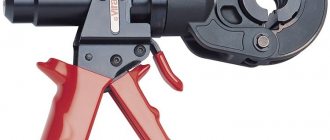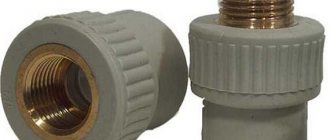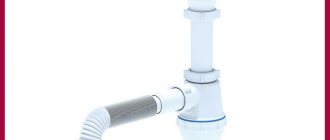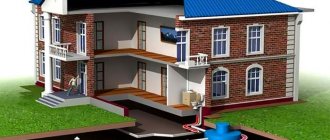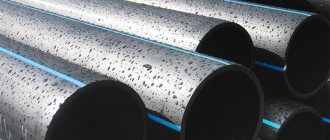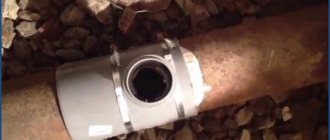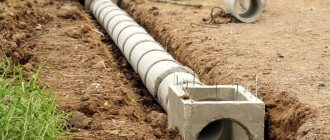Hello! If you have ever lived in a high-rise building built in the 80s of the last century or earlier (and there are more than half of such buildings in our cities), then you probably know firsthand about the problems of leaks and floods. It’s scary to imagine how many square meters of fresh (and not so fresh) renovations were flooded by the neighbors above.
In this situation, you will not envy either the flooded person or the culprit. The reason, in most cases, is improperly installed joints of water and sewer pipes. Therefore, connecting communications with each other must be treated with the highest degree of responsibility, and my article today is exactly about this.
I propose to find out how to connect a metal pipe with a plastic one, while avoiding disasters on a domestic scale.
When is such a connection required?
Connecting plastic and metal pipes is required quite often.
All the reasons can be summarized into 3 conditional points:
- Planned and urgent replacement of internal communications
In the 20th century, all houses were equipped mainly with cast iron pipelines. Gradually, cast iron fails and is replaced by plastic and metal-plastic. Polymer products are much cheaper, more practical and easier to install. It is impossible to replace all communication lines in the house and in each individual apartment at once. Therefore, during repair work, old cast iron pipes are connected to new plastic ones.
- Construction
During the construction of any industrial and civil buildings, structures, as well as the laying of pipeline lines, one section is often installed by one contractor, and the next by another. And their work is not always coordinated, and the materials used are the same. Therefore, alternating metal and plastic communications is a common situation in domestic construction.
- Special cases
Sometimes situations arise in which the use of different materials is technologically necessary. For example, part of the pipeline is subject to high mechanical loads, and part is subject to corrosion or high temperature. In this situation, stronger steel elements are installed in problem areas, and all the rest are mounted from plastic.
Correspondence of diameters of steel and polypropylene pipes (table)
When replacing an old pipeline, increased attention is paid to the ratio of the diameters of metal and polypropylene pipes. After all, the outer diameter of the polymer pipe can be 16-110 mm. At the same time, have different wall thicknesses.
At the same time, rolled steel pipes are manufactured with a different outer cross-section and the same internal diameter as PP pipes.
It is also worth knowing that the labeling of polymer products does not indicate the internal diameter. However, it is not difficult to calculate it when the outer section and wall thickness are known. The difference between these values will correspond to the desired value.
When replacing old steel utility lines with a polypropylene system, it is important to consider the following:
- Metal pipes for water supply and gas networks have an internal surface that is not perfectly smooth, which reduces throughput.
- Rolled metal pipes are available in lightweight and reinforced versions. Each type of pipe has a different wall thickness. In other words, with the same cross-section along the outer edge, pipe products will have different internal diameters. This is what is taken into account when the utility network is replaced.
- Metal and PP pipes are created according to different GOSTs. Therefore, to select polymer pipes, you need to know all the characteristics of plastic products.
Threaded
It is used in cases where the diameter of the parts to be connected does not exceed 40 mm. In this method, docking occurs using a special device. One end of this device is metal with a thread applied to it. A metal pipe is screwed to it. The other end is plastic. Plastic is connected to it using a union nut or soldering.
Connecting devices are divided into three types:
- American
The most popular option. “American” is a special element consisting of a metal part with an applied (internal or external) thread and a plastic pipe.
The connection of a metal pipe with an “American” is made by screwing a special union nut onto the thread; on the other hand, the plastic part is welded using a special soldering iron. Sealing is ensured by installing a rubber gasket.
The advantage of this adapter is its detachability. If necessary, the pipes can be disconnected. When unscrewing the metal part, it is important not to damage the rubber gasket.
- Nipple fitting
It is a plastic sleeve with a threaded metal plate soldered inside.
One part of the fitting nipple is screwed onto the external thread of the attached iron pipe, the second part is soldered to the polypropylene product. Be sure to use a sealant, such as FUM tape.
- Metalsleeve
The metal hose is a flexible hose with sealing collars and union nuts. Diameter varies.
Docking using a metal hose is the least common option. But when you need to fasten parts that are distant from each other, this method is optimal. The metal pipe is screwed to one of the parts of the metal hose, and to connect the plastic pipe, a fitting nipple is again used. When choosing a hose and nipple fitting, you should pay attention to the thread of the product.
Flanged
In cases where the pipe diameter is greater than 40mm, it is convenient to use flanges for connection.
In this case, the flange should be plastic (metal will not work) with additional bushings with collars and restrictive sides. If a metal part already has a flange, you need to choose a plastic one according to its size.
A sleeve with a collar is put on the ends of the elements to be connected, the flanges rest against the collar. Sealing is achieved using rubber or paronite gaskets. Bushing collars can be straight or conical (in the figure above, a conical collar). The flanges are attached with bolts or studs. The fasteners are tightened crosswise, without any compression force.
Fitting
The connection using the Gebo fitting is gaining increasing popularity.
Gebo fitting is a compression coupling in the form of a pipe. The Gebo fitting includes several rings - a clamping ring, a pressure ring, a sealing ring and a union nut. Each of the elements has a pair and they are located at both ends of the coupling. This connection option is used when threads cannot be applied to the metal.
Connection sequence:
- The fitting unscrews;
- All clamping rings are put on the connected products;
- A coupling is attached to one of the pipes, pressed using a union nut;
- The same thing happens with the other pipe.
This connection ensures 100% tightness of the joint, but the fitting itself cannot be loaded.
Threadless
Connection using a crimp coupling.
The coupling consists of the following parts:
- Housing made of high-strength steel or cast iron;
- Two brass or bronze nuts located at both ends of the body;
- Four metal washers installed in the internal cavity of the housing;
- Sealing rubber gaskets.
Metal and plastic pipes are inserted into the coupling each to the middle, until they touch. The nuts are tightened until they stop.
There is another method of threadless connection. A metal hose is used for this. The hose is placed over the edges of the parts to be connected and crimped with special clamps. Now on the market you can find rubber bushings that work using this method.
There is also a completely “barbaric” way of connecting a polymer pipe with a metal thread without using any fittings. This method, by the way, is shown in the video below. Here, a plastic pipe is heated from the inside with a special “iron” and then screwed onto a metal thread. Hot plastic envelops the metal and creates a fairly strong connection.
But personally, I think this method is absolutely unreliable and I do not recommend using it in intra-apartment communications.
Video description
This video shows how to make a fitting connection
Gebo fastener
One of the popular ways to connect pipes without welding and threading is Gebo fasteners. It is well suited for joining both homogeneous and pipes made of different materials, for example, for joining cast iron and steel pipes with plastic, or with each other.
Essentially, this is a clamp fitting that comes in single- and double-sided (more common). One of the varieties of Gebo is made in the form of a tee, with which you can make both connections and adapters. The fastener consists of a body, a clamping ring, seals on the sides, as well as a cone nut, which compresses all parts together.
Such a system is quite simple to install, even if you have no plumbing experience:
- It is necessary to sand the future joints.
- Next, you need to put on the nut and rings in a certain sequence: clamping, pressing and sealing.
- Then the Gebo mount itself is put on and clamped with a nut.
Application of Gebo fasteners Source yandex.net
Step-by-step connection instructions
How to connect a PVC pipe to a metal one
Plastic and metal pipes must be fastened in the following sequence:
- Select the connection method;
- We measure the internal and external diameters of the products being connected;
- We purchase all the appropriate fittings (pay special attention to the type of thread - internal or external;
- We apply markings on the pipeline;
- We cut the edge of the plastic pipe as smoothly as possible and clean the metal one; if necessary, cut off the old one and apply a new thread;
- We place a sealing gasket on the metal part;
- We screw the necessary fitting to it, or attach a flange;
- In the case of a flange connection, we move the flange towards the gasket and connect it to another flange with studs or bolts;
- In the case of a threaded connection, the metal part is cleaned, a sealant or fum tape is applied, the fitting is screwed on manually, the edge of a plastic pipe is installed in the mating part, and if necessary, it is welded;
- Check the connection for leaks.
How to connect a metal pipe with metal-plastic
It is optimal to connect metal-plastic with metal using a compression fitting. Sequence of actions step by step:
- We clean the steel threads from rust and dirt;
- Apply a layer of insulation (tow, fum tape);
- We screw the fitting onto the metal pipe using an open-end or gas wrench;
- We put the press washer together with the nut on the edge of the metal-plastic pipe and calibrate it;
- We place the end of the metal-plastic pipe on the fitting screwed to the metal one;
- Using a wrench, tighten the crimp nut tightly.
How to switch from a metal pipe without threads to a plastic one
In some situations, a plastic pipe needs to be attached to a metal piece without threads. And here there are 2 options - either use the above-mentioned crimp coupling for threadless connections, or apply the thread yourself.
To apply threads yourself, you will need a special thread-carrying tool (thread cutter). Electrical and mechanical models are available for sale. The electric version includes several cutters for pipes of different diameters. This model is more convenient and lighter than a mechanical one, but costs much more.
Hand tools are cheaper, but working with them requires considerable physical strength and a certain skill.
Rules for using a thread cutter:
- Do not use the tool when the pipe is located near walls;
- When working with a manual machine, you should strictly observe the sequence of movements - half a turn forward, then a quarter back, and so on along the entire length of the thread;
- The electric tool heats up quickly and needs rest periodically;
- Before cutting, the metal must be cleaned;
- The resulting threaded grooves must be lubricated with grease or other lubricant.
How to properly connect a plastic pipe to a cast iron sewer?
Old and bulky cast iron pipelines can still be found in many apartments. But no matter how reliable they may seem, sooner or later their service life comes to an end. An excellent solution would be to completely replace cast iron with plastic, but, unfortunately, this is not always possible.
Some are stopped by the financial side of the issue, others are unable to come to an agreement with their neighbors. It is in such situations that the need arises to connect plastic and cast iron sewer sections. There are several methods that allow you to carry out such work quickly, efficiently, and without the involvement of professional help.
Features of some types of connections
Sewer pipes
When laying and repairing sewer networks, it often becomes necessary to connect plastic pipes (most often made of PVC - polyvinyl chloride) with cast iron ones. This is done with the help of special components - cuffs, seals, corrugations. If there is a total shortage of these parts in construction stores in your city, you can make a seal yourself, from porous rubber.
The most important thing here is to clearly understand that sealing with caulking or cement is unacceptable.
Due to the high temperature difference, the cement screed will quickly crack and lose its tightness. Embossing, in turn, deforms the plastic pipe and the joint will not be tight.
Heating or plumbing
In heating and water supply systems, liquid moves under pressure, and accordingly all joints must withstand this pressure.
To connect the elements, either a thread or a flange is used; there are no other options. Since the diameters of pipelines in everyday life are usually small, a threaded connection is optimal. Very rarely does it become necessary to connect a plastic pipe not to an iron one, but to a copper one. Fittings for such a connection can also be found on sale.
Water supply for a suburban area
In summer cottages, most often the polymer pipe must be connected to the pump. In these cases, the best connection assistant is a compression HDPE coupling. They can withstand high pressure (up to 16 atmospheres) and provide complete sealing.
When installing the HDPE coupling, it is necessary to ensure that there are no sharp edges on the pipe that could damage the seal.
Comparison of properties
Pipes made from different materials are connected using a special technology. In order for the entire joining process to proceed correctly, you need to know the properties of each material. Metal products include structures made of cast iron, steel and copper. They have different technical characteristics and are used in different areas. Plastic pipes are made from polymers such as polyethylene, PVC and polypropylene. They are installed in communication networks. Comparison of properties:
- Copper products are installed in the plumbing and heating systems. But they are rarely used because they are expensive. This material has good performance properties.
- For sewers and free-flow water pipes, cast iron products are used. The material can withstand high loads, but is fragile to impacts. Cast iron pipes have a long service life and low price.
- Steel products are made from stainless steel, galvanized or carbon steel. The most expensive models are made of stainless steel. Their cost will pay off over time, since they have an indefinite service life. The service life of simple steel pipes is several times shorter, as they are susceptible to corrosion. Galvanized structures have average characteristics and tolerate contact with water well.
- PVC products are installed in sewer systems. Fragility is the main disadvantage of the material.
- When laying communication systems, polypropylene products are most often used. They have good performance characteristics and have no disadvantages.
- The main properties of polyethylene products are elasticity and density. The material does not tolerate low temperatures well, which is its only drawback.
Pipe connections can be made in several ways. The choice of method depends on the material from which the pipes are made.
Expert advice
In conclusion, here are some important tips on how to ensure tightness and avoid leaks.
- Always use a sealant. Depending on the type of connection, it can be rubber, natural, or in the form of a special tape. Joints without sealant will let water through;
- Connect the elements correctly. Check whether the pipe fits tightly into the fitting or coupling;
- If a pressure fitting is used, check the fit of the compression fitting. You can tighten it with press pliers;
- Be careful when tightening parts. Brass fittings are fragile and can be easily damaged by tools;
- The end of the metal pipe must be calibrated until completely smooth;
- Periodically check the condition of the O-rings and change them if necessary.
